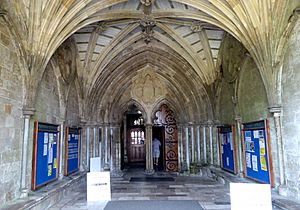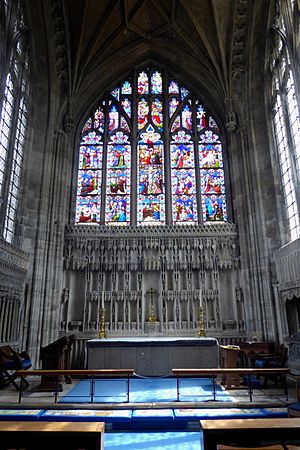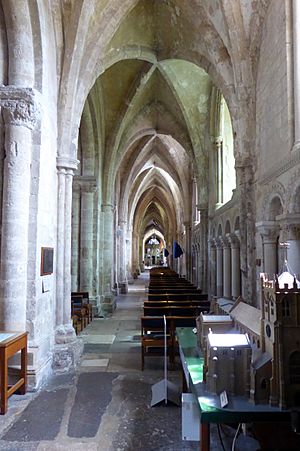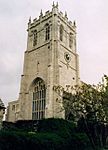Christchurch Priory facts for kids
Quick facts for kids Christchurch Priory |
|
|---|---|
| Priory Church of the Holy Trinity, Christchurch | |

Christchurch Priory, seen from its extensive churchyard (January 2015)
|
|
| Country | United Kingdom |
| Denomination | Church of England |
| Churchmanship | Broad Church |
| Website | www.christchurchpriory.org |
| History | |
| Dedication | Holy Trinity |
| Specifications | |
| Length | 311ft (91m) |
| Tower height | 120ft (37m) |
| Bells | 13 |
| Tenor bell weight | 27-0-0 |
| Administration | |
| Parish | Christchurch |
| Diocese | Winchester |
| Province | Canterbury |
Christchurch Priory is a very old and large church in Christchurch, England. It used to be a priory, which is a type of monastery. It is one of the longest parish churches in the country. It is even bigger than 21 of England's main cathedrals!
Contents
- Early History of Christchurch Priory
- Changes from the 12th to 14th Centuries
- Building in the 14th to 16th Centuries
- The Christchurch Priory Cartulary
- The Miraculous Beam
- Misericords
- The Dissolution
- After the Dissolution
- Christchurch Priory Today
- The Bells of Christchurch Priory
- Music at the Priory
- Burials
- Gallery
- Images for kids
Early History of Christchurch Priory
The story of Christchurch Priory began a long time ago, around the middle of the 11th century. The Domesday Book from 1086, which was a big survey of England, mentions that there was a priory here during the time of Edward the Confessor. This church was built on the site of an even older church from about 800 AD.
Around 1094, a powerful minister of King William II, named Ranulf Flambard, started building a new church. A local story says that Flambard first wanted to build the church on top of St. Catherine's Hill. But overnight, all the building materials mysteriously moved to where the church stands today!
Even though Flambard became a bishop in 1099, the building work continued. By about 1113, the new church was almost finished. Around 1150, the church was mostly built in the Norman style. It had a nave (the main part of the church), a central tower, and a quire (the area where the choir sits). It was around this time that the legend of the miraculous beam began, which you can read about below.
Changes from the 12th to 14th Centuries
In 1150, Baldwin de Redvers, who was the Lord of Christchurch, changed the church into an Augustinian priory. His family supported the priory for 150 years. Then, in 1293, Isabella de Fortibus, the last of the de Redvers family, sold her lands to King Edward I. This made Christchurch a Royal Manor, meaning it belonged to the King.
In the 13th century, a lot of building happened. The sides of the nave were given arched ceilings, and the clerestory (the upper part of the nave with windows) was built. Work also started on the North Porch, which is very large and impressive.
Building in the 14th to 16th Centuries
Building continued in the 14th century. The roof of the nave reached its current height by 1350. Towards the end of the 14th century, work began on the Lady Chapel, which was finished in the early 15th century. Its unique ceiling, called a pendant vault, was one of the first of its kind in England.
Also in the 15th century, the old quire was replaced and made longer to connect with the new Lady Chapel. The church's tower was rebuilt between 1470 and 1480. By 1529, special chapels were completed. By this time, the church looked very much like it does today.
The Christchurch Priory Cartulary
Much of what we know about Christchurch from the 11th to the mid-14th century comes from the Christchurch Priory Cartulary. This book contains copies of over 1,300 important documents from the monastery. Most of it was written by just two clerks, with the main part finished by 1372.
The cartulary was later found in an old cupboard in the British Museum in 1837. Today, it is kept in the British Library. In 2007, the entire cartulary was translated and published, helping us learn more about the priory's past.
The Miraculous Beam
The legend of the miraculous beam is a famous story from the early 12th century. The story says that a wooden beam was cut too short for the church. This was a big problem because wood was expensive and hard to replace.
A mysterious carpenter worked and ate alone. The next day, the other carpenters returned and found the beam perfectly fitted into place! The unknown carpenter was never seen again. People believed it was Jesus Christ himself who had helped. Because of this event, the church became known as Christ's Church of Twynham. Over time, the town's name changed from Twynham to Christchurch. You can still see the miraculous beam in the church today.
Misericords
The Priory has 39 special carvings called misericords. These carvings are found on the underside of hinged seats in the choir stalls. They date from three different periods: 1250, 1350, and 1515. They show a mix of mythical creatures and scenes from old stories, some from Aesop's Fables. Some also show religious symbols.
The Dissolution
On November 28, 1539, the priory was closed down during the Dissolution of the Monasteries. The King had planned to tear down the church, but the people of Christchurch asked him to save it. They were supported by the last prior, John Draper.
So, on October 23, 1540, the King gave the church and its churchyard to the people of Christchurch to be used as their parish church forever. This was confirmed again in 1612 by King James I.
After the Dissolution
After the priory closed, a group called 'The Sixteen' was formed to manage the church and its affairs.
In 1788, a pipe organ was given to the priory. Later, in the late 19th and early 20th centuries, many repairs were done to keep the old building strong. In 1912, a new floor was laid in the nave.
A monument to the poet Percy Bysshe Shelley and his wife Mary Wollstonecraft Shelley was placed in the Priory church in 1854. It was put there by their son.
The War Memorial Chapel was dedicated in 1922 to remember those who served. Electric lighting was installed in June 1934.
Christchurch Priory Today
In 1976, a beautiful stained-glass window was donated to the priory. It came from an old abbey in France and shows the lives of Saint Francis of Assisi and Saint Anne.
In 1999, a new window was installed to celebrate the priory's 900th anniversary. It shows a starry night with the Cross of Christ. Christchurch Priory is still a very active church today, with daily services and many visitors.
In March 2021, a special carving of an NHS worker wearing a mask was added to the priory. This carving is a permanent tribute to the amazing efforts of the National Health Service during the Covid-19 pandemic. It was inspired by a photo of a doctor and represents all NHS workers for centuries to come.
The Bells of Christchurch Priory
Christchurch Priory has a set of 12 bells, plus an extra one. The bells are rung twice on Sundays, on Monday nights, and for special services. The largest bell, called the Tenor, weighs about 1½ tons! The two oldest bells were made in 1376.
When the priory closed in 1539, there were seven bells. Over the centuries, more bells were added and some were replaced. In 1932, the number of bells was increased to twelve. The bells are still rung regularly today.
Music at the Priory
The Choir
The priory has a boys' choir, a girls' choir, and a men's choir. Children in the choir can earn medals as they improve their skills and gain experience.
The choir sings for three services on Sundays during term time:
- Eucharist: 9:30 AM - 10:30 AM
- Matins: 11:30 AM - 12:15 PM
- Evensong: 6:30 PM - 7:30 PM
The men sing at all three services. The children's choirs take turns singing at the morning services and the evening service each week. Sometimes, like at Christmas and Easter, both children's choirs sing with the men.
The Organ
On July 17, 1999, a new pipe organ was installed in the church. It was rebuilt from an older organ and is very large, weighing about 20 tonnes! It has nearly 4,000 pipes, and some of them are from the original organ from 1788. This new organ cost over £500,000, with a lot of the money coming from the National Lottery Fund.
Burials
Some notable people buried at Christchurch Priory include:
- Sir Thomas West (died 1386) and his wife Alice FitzHerbert (died 1395)
- Thomas West, 1st Baron West
- William de Redvers, 5th Earl of Devon
- John Draper, the last prior of Christchurch
Gallery
Images for kids













